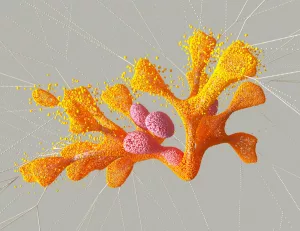Smart fridges are transforming kitchens by using cutting-edge technology to keep our food fresher for longer. They offer a blend of sensors, connectivity, AI, and more to track the freshness of your food. Let’s dive deeper into how these technologies work together to create a seamless experience for users.
Sensors and Imaging Technology
Smart fridges are packed with sensors that constantly monitor the internal environment. Temperature sensors ensure that each compartment maintains the ideal climate for different food types. For example, meats might be stored at a slightly lower temperature than vegetables to prolong freshness. Humidity sensors play a crucial role, especially in vegetable crispers, where maintaining higher humidity can prevent leafy greens from wilting.
Imagine a scenario where you’re storing strawberries. The fridge’s gas sensors can detect ethylene, a gas given off by many fruits that accelerates ripening. If levels get too high, the fridge might suggest rearranging your produce or consuming the more sensitive items first.
The use of imaging technology provides a visual inventory. A camera inside the fridge can snap pictures of the contents whenever the door is opened and closed. This isn’t just about checking if you have milk; advanced image processing can evaluate the color and texture of produce, giving you hints about freshness. For instance, if the lettuce looks limp, a notification can prompt you to consume it soon.
Practical Tip: Keep your fridge organized and avoid overcrowding. This allows air to circulate properly and ensures the sensors and cameras can effectively monitor each item.
Advanced Sensor Technology
Beyond the basic sensors, some smart fridges now incorporate multi-spectral imaging. This technology can analyze food at a molecular level, detecting changes that aren’t visible to the naked eye. By assessing the spectral signature of an apple, for instance, the fridge might predict spoilage before it becomes apparent.
Example: A household with a multi-spectral imaging-equipped fridge received an alert about a batch of apples that appeared fresh but were beginning to spoil internally. By consuming them sooner, they avoided waste and enjoyed their fruit at peak quality.
Internet of Things (IoT) Connectivity
The IoT is the backbone of a smart fridge’s connectivity and remote capabilities. By linking the fridge to your home Wi-Fi, you can access its features through a smartphone app. Whether you’re at work or on vacation, you’ll receive real-time updates about your fridge’s status.
Consider a power outage scenario. The fridge can send alerts to your phone, allowing you to take action before food spoilage occurs. Moreover, IoT connectivity means your fridge is continually updated with the latest software, enhancing its ability to track and maintain food freshness.
Example: A family in San Francisco uses their smart fridge’s app to create a shopping list. As they shop, they can cross-check with the fridge inventory to avoid buying duplicates or missing essentials.
Integration with Smart Home Ecosystems
Smart fridges are increasingly integrating with broader smart home ecosystems. They can sync with devices like smart speakers, allowing for hands-free operation. Imagine asking your smart assistant to check the fridge’s contents or add items to your shopping list as you cook.
Tip for Integration: Ensure your smart fridge is compatible with your existing smart home systems. This can maximize convenience and create a more cohesive home automation experience.
Artificial Intelligence and Machine Learning
AI and machine learning algorithms are the brains behind a smart fridge’s ability to predict and adapt. They analyze patterns in food consumption and spoilage, learning from each user’s habits. Over time, the fridge can offer personalized tips, like suggesting you store apples in the crisper to keep them fresh longer.
For instance, if the fridge notices you often forget about leftovers, it might suggest placing them at eye level or sending reminders to your phone. Machine learning models can also recognize when food quality is declining, such as when cheese starts to mold, and notify you accordingly.
Common Mistake to Avoid: Ignoring AI suggestions. These recommendations are based on your unique usage patterns and can significantly reduce waste and enhance nutrition.
Personalization and Adaptation
A standout feature of AI is its ability to personalize the user experience. By understanding your dietary preferences and restrictions, a smart fridge can tailor its suggestions. For example, if you’re a vegan, the fridge might prioritize plant-based recipes and alert you to potential allergens in new products.
Case Study: A couple with diverse dietary needs—one vegan, the other not—found harmony through their smart fridge. By providing personalized meal suggestions and reminders, it helped them balance their different diets seamlessly.
RFID and Barcode Scanning
RFID and barcode technology streamline the process of tracking food inventory. When you place a new item in the fridge, simply scan its barcode or RFID tag. The fridge automatically logs the item, its expiration date, and nutritional information.
Case Study: A busy professional uses the barcode scanner to log her groceries. The fridge alerts her when items are nearing expiration, prompting her to incorporate them into her meal plans, thus reducing waste and saving money.
Beyond just tracking, this technology can assist with dietary goals. If you’re monitoring calorie intake or avoiding allergens, the fridge can filter recipes and suggest meals that align with your needs.
Enhancing Inventory Management
Some advanced models go beyond basic scanning, employing natural language processing to recognize spoken inventory updates. This feature allows users to verbally update their fridge’s inventory while multitasking, making it even easier to maintain an accurate log.
Practical Tip: Consistently update your fridge’s inventory for the most accurate reminders and meal suggestions. This habit can also help you identify shopping trends and adjust habits to minimize waste.
Energy Efficiency and Environmental Impact
Smart fridges aren’t just about keeping food fresh; they’re also designed to be energy-efficient. They optimize cooling cycles based on usage patterns, minimizing power consumption. Some models even integrate with smart home systems to operate during off-peak energy hours.
Data Point: A study by the National Renewable Energy Laboratory found that smart appliances, including fridges, can reduce household energy consumption by up to 10%.
Opting for a smart fridge contributes to a more sustainable lifestyle. By preventing food waste, you’re reducing the environmental impact associated with food production and disposal.
Sustainable Features and Innovations
Recent innovations focus on sustainability. Some smart fridges use eco-friendly refrigerants and materials, further reducing their environmental footprint. Additionally, features like dynamic cooling zones allow users to adjust compartment temperatures, saving energy by only cooling areas as needed.
Example: An eco-conscious family in Seattle uses their smart fridge’s dynamic cooling feature to minimize energy use during winter, when fresh produce is stored in a cooler pantry.
Future Trends in Smart Fridge Technology
Looking ahead, the integration of augmented reality (AR) could allow users to visualize recipes with ingredients they have on hand. Imagine pointing your smartphone at the fridge, and an AR app suggests meals, complete with step-by-step cooking instructions.
Another exciting development is the use of blockchain technology for food traceability. This could enable consumers to track the journey of their food from farm to fridge, ensuring quality and ethical sourcing.
Innovative Concept: Picture a future where fridges communicate with local farmers’ markets using blockchain, providing real-time updates on the freshest available produce, directly influencing your grocery choices.
Expanding Connectivity and Beyond
As technology continues to evolve, the potential for smart fridges is vast. 5G connectivity promises faster, more reliable communication between devices, enhancing real-time updates and remote management.
Tip for Future-Proofing: Keep an eye on emerging technologies and consider models that offer modular upgrades, ensuring your smart fridge remains cutting-edge without needing a complete replacement.
Final Thoughts
Investing in a smart fridge is not just about convenience; it’s about making informed choices that benefit your health, wallet, and the planet. By embracing these technologies, you’ll enjoy fresher food, less waste, and a more efficient kitchen.
Understanding and utilizing the full capabilities of a smart fridge can transform your everyday life. From reducing food waste to conserving energy, these appliances are a step towards a more sustainable and efficient future. As you explore the features of your smart fridge, remember that it’s an evolving tool designed to adapt and enhance your lifestyle. Embrace the innovations, stay curious about upcoming features, and enjoy the peace of mind that comes with a well-managed kitchen.



